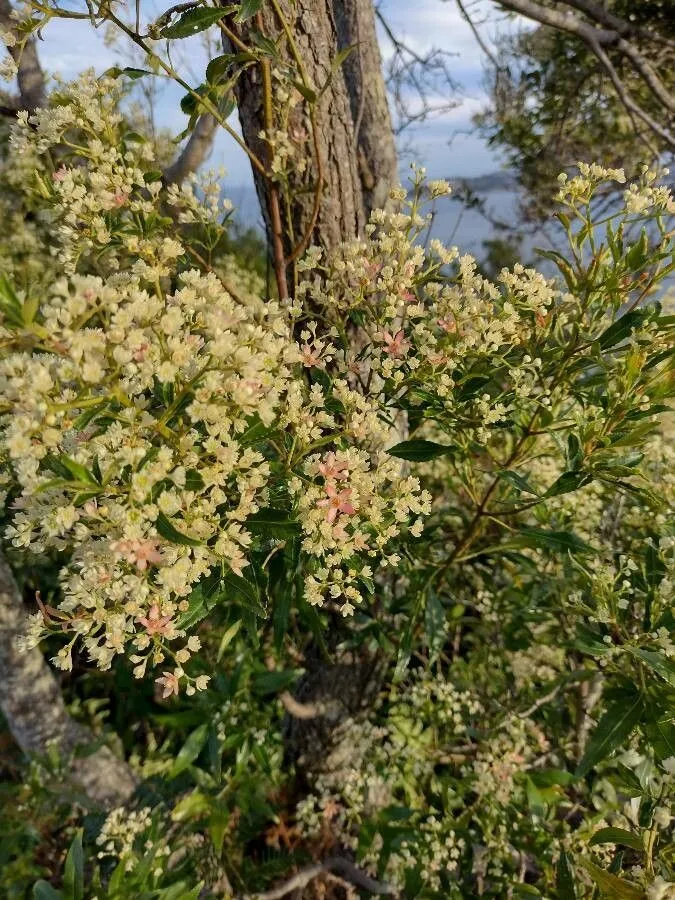
Author: Sm.
Bibliography: Spec. Bot. New Holland: 9 (1793)
Year: 1793
Status: accepted
Rank: species
Genus: Ceratopetalum
Vegetable: False
Observations: New South Wales
The Christmasbush, scientifically known as Ceratopetalum gummiferum, is a captivating native plant extensively observed in New South Wales. First described in the notable botanical publication “Spec. Bot. New Holland” in 1793 by the author Sm., this evergreen species has garnered attention not just for its scientific significance, but also for its ornamental beauty and cultural relevance.
Belonging to the Cunoniaceae family, the Christmasbush is a small to medium-sized tree that typically flourishes in the eastern Australian landscape. It is best recognized for its striking transformation during the festive season, which also lends it its common name. As the holiday season approaches, the once inconspicuous green foliage undergoes a spectacular change, with bracts turning into vibrant shades of red, pink, or pure white, creating a festive display reminiscent of Christmas decorations.
Ceratopetalum gummiferum thrives in well-drained soils and prefers sunny to partly shaded environments, making it a versatile plant for different garden settings. It is also known for its resilience and adaptability to various climatic conditions prevalent in its native region. Furthermore, the plant produces small white flowers around November to February, which are not only visually appealing but also attract local wildlife, including bees and birds that aid in pollination.
The Christmasbush holds a cherished place in Australian culture, often used as a decorative plant during the holiday season. Its vibrant colors and festive appearance make it a popular choice for Christmas-themed floral arrangements and garden displays. Additionally, it has been used in traditional practices and holds ecological importance within its native habitat, contributing to the biodiversity of the region.
In summary, Ceratopetalum gummiferum, or Christmasbush, is more than just an aesthetically pleasing plant; it is a species rich in history, cultural significance, and ecological value. The vivid transformation of its bracts and its hardy nature make it a standout species within the Cunoniaceae family, offering both beauty and function to the landscapes of New South Wales.
Eng: christmasbush
En: Christmasbush
Taken Oct 28, 2022 by Danielle Stig (cc-by-sa)
Taken Dec 11, 2020 by Dukes Ashleigh (cc-by-sa)
Taken Jul 25, 2022 by Michal Svit (cc-by-sa)
Taken Nov 3, 2021 by Boris Therock (cc-by-sa)
Taken Mar 18, 2022 by Arba khanam (cc-by-sa)
Taken Nov 3, 2021 by Boris Therock (cc-by-sa)
Taken Dec 12, 2021 by Arba khanam (cc-by-sa)
Taken Nov 3, 2021 by Boris Therock (cc-by-sa)
Taken Sep 18, 2020 by blue Hat (cc-by-sa)
Taken Oct 28, 2022 by Danielle Stig (cc-by-sa)
Taken Oct 30, 2022 by Anton Johnston (cc-by-sa)
Taken Oct 28, 2022 by Danielle Stig (cc-by-sa)
Taken Nov 5, 2022 by Kim Racovalis (cc-by-sa)
Taken Oct 28, 2022 by Danielle Stig (cc-by-sa)
© copyright of the Board of Trustees of the Royal Botanic Gardens, Kew.
Family: Myrtaceae Author: (F.Muell.) K.D.Hill & L.A.S.Johnson Bibliography: Telopea 6: 402 (1995) Year: 1995 Status:…
Family: Rubiaceae Author: Pierre ex A.Froehner Bibliography: Notizbl. Bot. Gart. Berlin-Dahlem 1: 237 (1897) Year:…
Family: Sapindaceae Author: Koidz. Bibliography: J. Coll. Sci. Imp. Univ. Tokyo 32(1): 38 (1911) Year:…
Family: Asteraceae Author: A.Gray Bibliography: Pacif. Railr. Rep.: 107 (1857) Year: 1857 Status: accepted Rank:…
Family: Fabaceae Author: Medik. Bibliography: Vorles. Churpfälz. Phys.-Ökon. Ges. 2: 398 (1787) Year: 1787 Status:…
Family: Aspleniaceae Author: (Cav.) Alston Bibliography: Bull. Misc. Inform. Kew 1932: 309 (1932) Year: 1932…